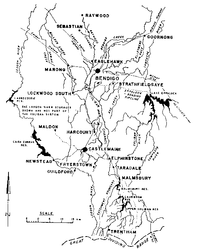


Chapter 3
I Background
II Early European Settlements
III Assessment Of Available Water Resources
IV Water Supplies For Goldmining Development
i Goldfields supply in Western Australia
ii The Coliban system of waterworks
V Irrigation Development
VI Farm And Stock Water Supplies
VII Urban Water Supplies
VIII Wastewater Management And Treatment
IX Water Quality Management
X Limnological And Water Quality Research
XI New Techniques In Water Resource Planning And Management
XII Legislation
XIII Conclusion
XIV List Of Abbreviations
XV Acknowledgements
XVI Plantations-high Productivity Resources
References
Index
Search
Help
Contact us

The Coliban system of waterworks
The Coliban system of water supply works in North Central Victoria is an interesting example of early hydraulic engineering made necessary by the great influx of migrants from Europe and America following the discovery of gold in 1851. Several accidents befell these works shortly after they came into service, and the subsequent remedial measures provided useful lessons for future engineers.The scheme had its origins in a Parliamentary enquiry of 1862 into the practicability and cost of carrying water from the Coliban River to the new mining towns of Bendigo and Castlemaine. Tenders were called shortly afterwards and the first reservoir was completed in 1870. This was formed by an earthen embankment 580 m long and 15 m high.
By 1903, the works comprised two principal reservoirs with a combined capacity of 32,700 ML, 25 subsidiary storages, 580 km of channels, 490 km of pipelines and some tunnels, supplying water to several towns with a combined population of 64,000 and providing for irrigation, mining and industry.
The early accidents included substantial damage to the first reservoir shortly after completion, following a flood of unexpected magnitude, and compounded by inadequate geological investigation of the site, damage from flood debris to the 2.4 m diameter outlet valve, and the collapse of the 2.4 m diameter cast iron pipeline carrying the main supply from the system by inverted siphon across a deep valley.
Ingenious remedial works overcame these and other massive problems and it was possible for the Chief Engineer of Water Supply to say in 1919 that:
the works of the Coliban System . . . have, without the adoption of heroic measures and at a cost not immoderate, been placed in an excellent condition of maintenance, improved and extended, and rendered capable of such further extension that they will, with proper upkeep and management, render efficient service to the public for many generations to come.
Today, after many modifications and extensions, and further remedial measures, the Coliban System serves a population of more than 64,000 and 400 ha of irrigation (Fig. 3). The early engineers' skills, initiative and faith have been vindicated.

Organisations in Australian Science at Work - Goulburn Weir, Vic.
 |
Australian Academy of Technological Sciences and Engineering |  |
© 1988 Print Edition pages 156 - 157, Online Edition 2000
Published by Australian Science and Technology Heritage Centre, using the Web Academic Resource Publisher
http://www.austehc.unimelb.edu.au/tia/154.html